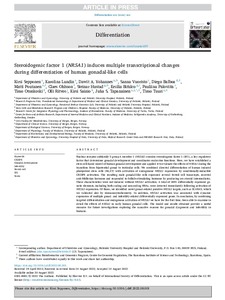Steroidogenic factor 1 (NR5A1) induces multiple transcriptional changes during differentiation of human gonadal-like cells
Sepponen Kirsi; Lundin Karolina; Yohannes Dawit A; Vuoristo Sanna; Balboa Diego; Poutanen Matti; Ohlsson Claes; Hustad Steinar; Bifulco Ersilia; Paloviita Pauliina; Otonkoski Timo; Ritvos Olli; Sainio Kirsi; Tapanainen Juha S; Tuuri Timo
https://urn.fi/URN:NBN:fi-fe2022110164061
Tiivistelmä
Nuclear receptor subfamily 5 group A member 1 (NR5A1) encodes steroidogenic factor 1 (SF1), a key regulatory factor that determines gonadal development and coordinates endocrine functions. Here, we have established a stem cell-based model of human gonadal development and applied it to evaluate the effects of NR5A1 during the transition from bipotential gonad to testicular cells. We combined directed differentiation of human induced pluripotent stem cells (46,XY) with activation of endogenous NR5A1 expression by conditionally-inducible CRISPR activation. The resulting male gonadal-like cells expressed several Sertoli cell transcripts, secreted anti-Müllerian hormone and responded to follicle-stimulating hormone by producing sex steroid intermediates. These characteristics were not induced without NR5A1 activation. A total of 2691 differentially expressed genetic elements, including both coding and non-coding RNAs, were detected immediately following activation of NR5A1 expression. Of those, we identified novel gonad-related putative NR5A1 targets, such as SCARA5, which we validated also by immunocytochemistry. In addition, NR5A1 activation was associated with dynamic expression of multiple gonad- and infertility-related differentially expressed genes. In conclusion, by combining targeted differentiation and endogenous activation of NR5A1 we have for the first time, been able to examine in detail the effects of NR5A1 in early human gonadal cells. The model and results obtained provide a useful resource for future investigations exploring the causative reasons for gonadal dysgenesis and infertility in humans.
Kokoelmat
- Rinnakkaistallenteet [27094]
